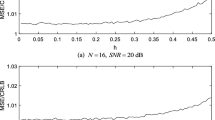Abstract
In many voice-related applications, the presence of echoes and overlapping speech signals can degrade the quality or intelligibility of a desired speech signal to be processed. It is, therefore, important to cancel the echoes and to separate overlapping speech signals from a mixture of these components, so that a specific function of the system, for instance, transmission, speech identification, or recognition, can be accomplished with better performance. However, in many cases we do not know the properties of the communication channel, and sometimes even the number of speech sources is unknown. In this paper, we propose to use a reference signal to determine the channel characteristics. When the estimated channel parameter matrices are obtained, a recurrence formula can then be used to separate various speech signals including their reverberant counterparts. As a finite impulse response (FIR) model is used to describe the observation model of the sources in the reverberant environment, it is not necessary for the processing speech signals to be uncorrelated. Because it involves only simple computation, our approach can be used in online applications. In this paper, we will investigate the validity of our algorithm and compare it with extended fourth-order blind identification (EFOBI). It is found that our method preserves both signal waveforms and their amplitudes even in a noisy environment, whereas EFOBI has not been able to achieve similar performance.
Similar content being viewed by others
References
Abe, M.; Fujii, K.; Nagata, N.; Sone, T.; and Kido, K., Estimation of the waveform of a sound source by using an iterative technique with many sensors,IEEE Trans. Speech and Audio Process., vol. 6, pp. 24–35, Jan. 1998.
Cardoso, J., Source separation using higher order moments,Proc. IEEE ICASSP, vol. IV, pp. 2109–2112, 1989.
Engebretson, A. M., Acoustic signal separation of statistically independent sources using multiple microphones,Proc. IEEE ICASSP, vol. II of V, pp. 343–346, 1993.
Golub, G. H., and Loan, C. V.,Matrix Computations, 2nd ed., Johns Hopkins Press, Baltimore MD, 1989.
Herault, J., and Jutten, C., Space or time adaptive signal processing by neural network models,AIP Conf. Proc., Snowbird, UT, pp. 206–211, 1986.
Lai, W., and Ching, P. C., A novel blind estimation algorithm,IEEE Trans. Signal Process., vol. 45, pp. 1763–1769, July 1997.
Mansour, A., and Jutten, C., Fourth-order criteria for blind sources separation,IEEE Trans. Signal Process., vol. 43, pp. 2022–2025, Aug. 1995.
Morgan, D. P.; George, E. B.; Lee, L. T.; and Kay, S. M., Cochannel speaker separation by harmonic enhancement and suppression,IEEE Trans. Speech and Audio Process., vol. 5, pp. 407–424, Sep. 1997.
Roy, R., and Kailailath, T., ESPRIT: Estimation of signal parameters via rotational invariance techniques,IEEE Trans. Acous. Speech Signal Process., vol. 37, pp. 984–995, 1989.
Schmidt, R. O., Multiple emitter location and signal parameter estimation,IEEE Trans. Antennas and Propagation, vol AP-34, pp. 276–280, 1986.
Soon, V. C.; Tong, L.; Huang, Y. F.; and Liu, R. W., An extended fourth-order blind identification algorithm in spatially correlated noise,Proc. IEEE Int. Conf. Acoustic Speech and Signal Processing, Albuquerque, NM, pp. 1365–1368, 1990.
Tong, L.; Liu, R. W.; Soon, V. C.; and Huang, Y. F., Indeterminacy and identifiability of blind identification,IEEE Trans. Circuits and Systems, vol. 38, pp. 499–509, 1991.
Tong, L.; Soon, V. C.; Huang, Y. F.; and Liu, R. W., Multiple source separation in noise,27th Annual Allerton Conference on Communications, Control and Computing, Urbana, IL, 1989.
Tong, L.; Huang, Y. F.; and Liu, R. W., A new blind identification algorithm,Proc. IEEE ISCAS, New Orleans, LA, pp. 1784–1787, 1990.
Author information
Authors and Affiliations
Rights and permissions
About this article
Cite this article
Li, W., Siu, W.C. & Poon, J.C.H. A new algorithm on multiple unknown source signals estimation and separation in a reverberant space. Circuits Systems and Signal Process 18, 489–504 (1999). https://doi.org/10.1007/BF01387468
Received:
Revised:
Issue Date:
DOI: https://doi.org/10.1007/BF01387468




